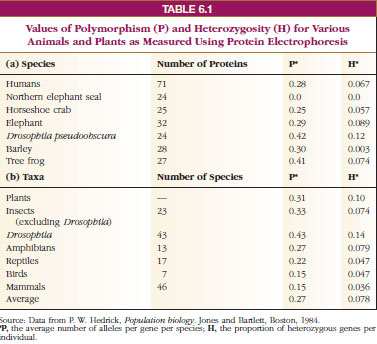Protein Polymorphism
Protein Polymorphism
Different allelic forms of genes encode proteins that may differ slightly in their amino acid sequence. This phenomenon is called protein polymorphism. If these differences affect the protein’s net electric charge, the different allelic forms can be separated using protein electrophoresis (Figure 6-30). We can identify the genotypes of particular individuals for protein-coding genes and measure allelic frequencies in the population.
Over the last 25 years, geneticists
using this approach have discovered
far more variation than was previously
expected. Despite the high levels of
polymorphism discovered using protein
electrophoresis (Table 6-1), these
studies underestimate both protein
polymorphism and the total genetic
variation present in a population. For
example, protein polymorphism that
does not involve charge differences is
not detected. Furthermore, because
the genetic code is degenerate (more
than one codon for most amino acids), protein polymorphism does
not reveal all of the genetic variation
present in protein-coding genes.
Genetic changes that do not alter protein
structure may alter patterns of protein
synthesis during development and
can be very important to an organism.
When all kinds of variation are considered,
it is evident that most species
have an enormous potential for further
evolutionary change.
Different allelic forms of genes encode proteins that may differ slightly in their amino acid sequence. This phenomenon is called protein polymorphism. If these differences affect the protein’s net electric charge, the different allelic forms can be separated using protein electrophoresis (Figure 6-30). We can identify the genotypes of particular individuals for protein-coding genes and measure allelic frequencies in the population.
![The study of genetic variation in proteins using gel electrophoresis. A, An electrophoretic apparatus separates allelic variants of proteins that differ in charge because of differences in their sequence of amino acids. B, Genetic variation in the protein leucine aminopeptidase for nine individuals of the brown snail, Helix aspersa. Two different sets of allelic variants are revealed. The top set contains two alleles [denoted fast (F) and slow (S) according to their relative movement in the electric field]. Individuals homozygous for the fast allele show only a single fast band on the gel (FF), those homozygous for the slow allele show only a single slow band (SS), and heterozygous individuals have both bands (FS). The lower set contains three different alleles denoted fast (F), medium (M), and slow (S). Note that no individuals shown are homozygous for the medium (M) allele.](images/images05/FIG030.jpg) |
| Figure 6-30 The study of genetic variation in proteins using gel electrophoresis. A, An electrophoretic apparatus separates allelic variants of proteins that differ in charge because of differences in their sequence of amino acids. B, Genetic variation in the protein leucine aminopeptidase for nine individuals of the brown snail, Helix aspersa. Two different sets of allelic variants are revealed. The top set contains two alleles [denoted fast (F) and slow (S) according to their relative movement in the electric field]. Individuals homozygous for the fast allele show only a single fast band on the gel (FF), those homozygous for the slow allele show only a single slow band (SS), and heterozygous individuals have both bands (FS). The lower set contains three different alleles denoted fast (F), medium (M), and slow (S). Note that no individuals shown are homozygous for the medium (M) allele. |
 |




